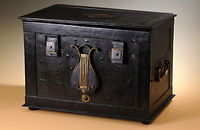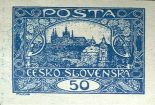Cash boxes
Cash boxes - boxes used for securing cash and valuable objects - were an integral part of the equipment of postal stations and offices from the very beginning of postal service in this area back in the 16th century. In a sense, they belonged to the very essentials to be found at every postal outlet as secure keeping of cash and other valuables has always played a key role in postal service.

The 17th and 18th-century cash boxes are among the oldest three-dimensional objects preserved by the Postal Museum as evidence of outstanding craftsmanship of the smiths and locksmiths of the time. Some of them have engraved or painted decorations with plant or landscape motifs. The cash box from Vrané nad Vltavou dated 1829 serves as evidence of period protection against thieves: it has an installed firing mechanism to be activated by anyone who might try to unlock the box without permission.
Relating to cash boxes is the set of safes, with the oldest one made by Viennese-based firm Wertheim in the late 19th century. The hand cash boxes, used by drivers of mail coaches and mixed mail and passenger coaches to carry cash and valuable mail, date back to the same period. Standardized hand cash boxes started to be introduced in post offices after 1900; this practice has survived until today and is documented in the sub-collection by several more recent cash boxes.
Photo gallery
-
 Massive iron cash box
Massive iron cash box Massive iron cash box
Pokladna kovaná pásovým železem a opatřená kovanými madly se uzavírala na čelní straně zámkem a dvěmi petlicemi, 17.-18. století.
-
 Painted cash box
Painted cash box Painted cash box
Ručně kovaná a malovaná pokladna s rostlinnými (květinovými) motivy z období kol. 1700. Pokladny tohoto typu byly velmi rozšířené a používaly se v různých úřadech zejména pro ukládání peněz a dalších cenných věcí.
-
 Cash box with a false lock
Cash box with a false lock Cash box with a false lock
Pokladna s falešným zámkem, kovaná železnými pásy a opatřená kovanými madly po stranách, se uzavírala pomocí dvou visacích zámků, 17.-18. stol.
-
 Cash box with an alarm mechanism
Cash box with an alarm mechanism Cash box with an alarm mechanism
Bezpečnostní pokladna s falešným zámkem, umístěným pod krytkou ve tvaru lyry. Zámek sloužil jako spoušť poplašného mechanismu, který je ukryt uvnitř pokladny a je založen na stejném principu jako u perkusní pistole. Při jeho aktivaci došlo k výstřelu z pravé boční strany pokladny, kde ústí hlaveň. Záměrem bylo vystrašit nenechavce, který by se pokusil neoprávněně pokladnu otevřít. Pravé zámky jsou umístěny pod dvěmi malými krytkami na čelní straně pokladny. Pokladnu zhotovil roku 1829 Jan Novák ze Dvora Králové nad Labem.

![Postal museum [logo]](/PostMuzeum-theme/images/muzeum/logo_postal-museum.png)










